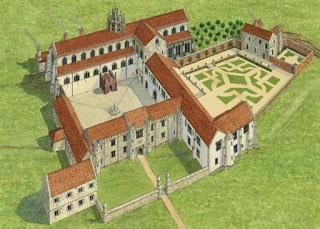He was born in the years 1483-1485 possibly at Fisherton Delamere in Wiltshire. His father was Sir John Paulet of a well-established west country family.
Quite early in his life he came to some prominence in Hampshire and was appointed High Sheriff for the county in 1512. He also held that office in 1519, 1523 and 1529. This last year brought him to London when he was elected to Parliament for Hampshire. He was the in his mid forties, well past the age when bright young men of the Tudor age were already making their mark, but clearly his intelligence, maturity and good sense commended itself to the king and he was soon entrusted with important missions.
In 1532 he accompanied the king to Calais and two years later was sent with the Duke of Norfolk to Rome to discuss Henry VIII's divorce from Catherine of Aragon. He was quickly rewarded. In 1536 he was appointed Keeper of Pamber Forest, a royal forest in North Hampshire. Subsequently he was appointed Steward of the Bishopric of Winchester and Comptroller of the Royal Household. He was closely associated with both Cardinal Wolsey and Thomas Crowell. He was created Baron St. John.
From the mid-1530s Paulet was always at the centre of government. He was a judge at several important trials, those of Sir Thomas More, the unfortunates who were held to be accomplices of Anne Boleyn and Bishop Fisher. He was given the job of Lord Chamberlain in 1535 and three years later became Treasurer of the Royal household.
It is a testament to his political skill that he survived the transition from Henry VIII to the court of Edward VI without losing office. In a similar fashion he lasted the reign of Mary and as a very old man was still at the centre of government during the reign of Elizabeth I. Honours accriued to him. n 1550 he was made earl of Wiltshire and in 1551 Marquess of Winchester. He died March 10th 1572.
During the course of this career he became wealthy and could easily afford to buy Netley Abbey in 1538 at the time of dissolution. Like many of his contemporaries he set about converting the old Abbey into a fine country house. Much of the old buildings were re-used and re-purposed. The nave of the church became a great hall and kitchens. The eastern end of the church was converted into spacious apartments and the cloister was retained as a courtyard. The south range was re-built in brick to accommodate a fashionable turreted gatehouse.
 |
| Drawing of the house as it may have appeared in the 16th century. (taken from English Heritage) |
The mansion survived in this form until the end of the 17th century when the then owner, Sir berkeley lucy, decided that the house was uninhabitable and decided to demolish it for the sale of the building materials. This work was contracted to William Taylor, a builder from Southampton in 1704. Unfortunately, part way through the course of this demolition the unfortunate Mr Taylor was killed by a falling stone and further demolition was abandoned.
What was left fell into ruin and decay. In 1760 Thomas Dummer moved the north transept to Cranbury Park near Winchester to construct a fashionable folly. It is still there.
In the late 18th and early 19th century, during the age known as the Romantic Period, many tourists came to the site to experience these old ruins. In 1860 an archaeological excavation was undertaken and at the same time most of the Tudor brickwork was removed to make the ruin more "authentic".









